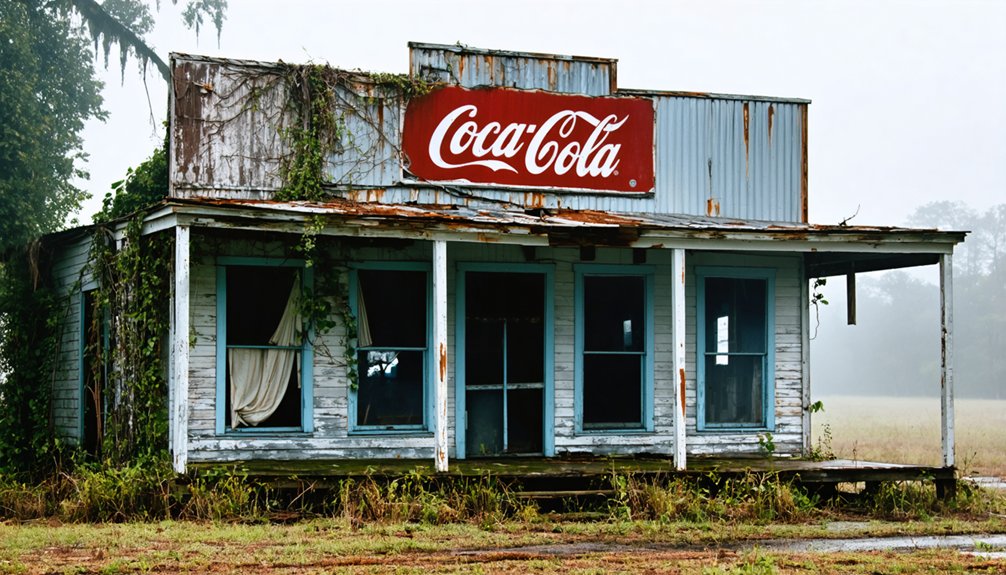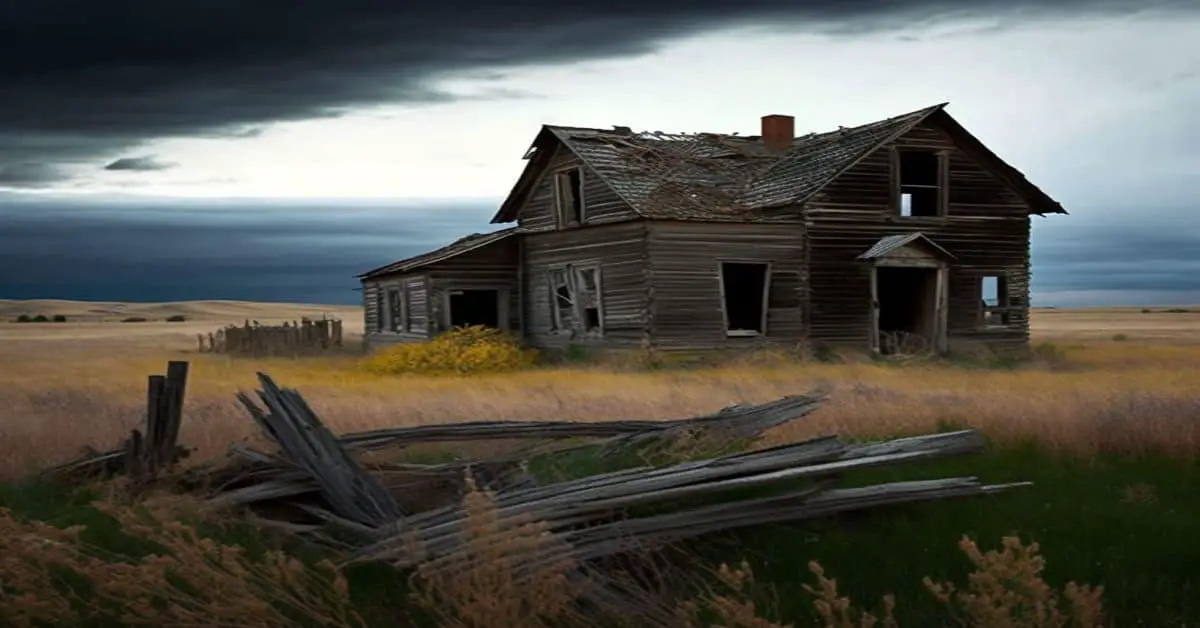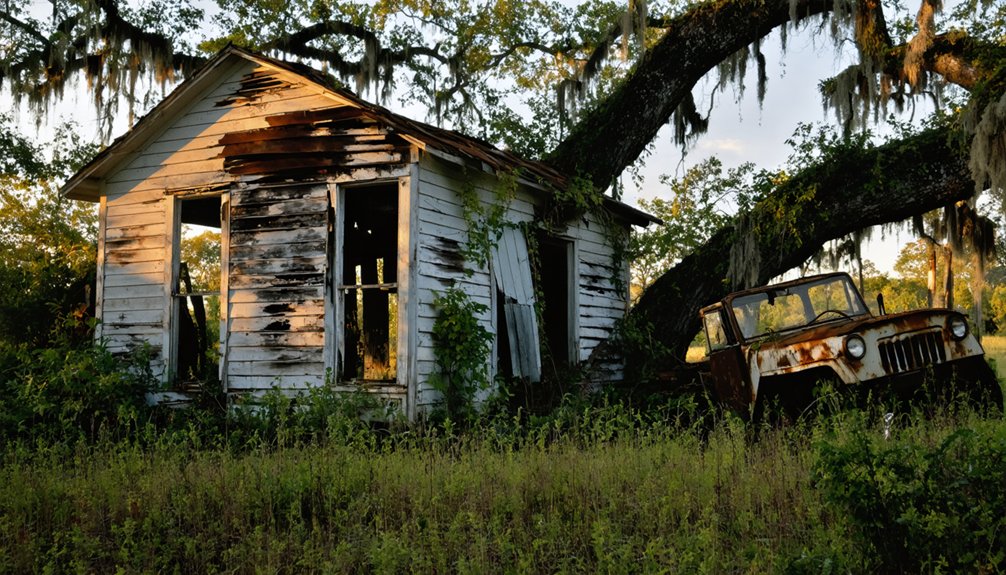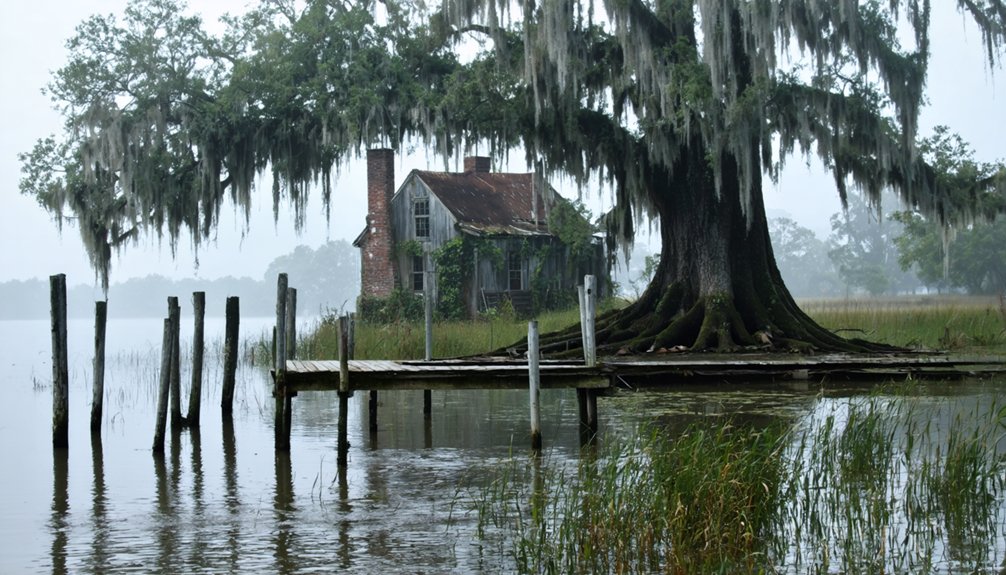You’ll find Alma’s remains in Pointe Coupee Parish, where this once-bustling sugar mill town began as a plantation in 1789. Founded by Julien Poydras and later owned by the Barrow family, Alma transformed into a major agricultural hub processing 60,000 acres of sugarcane annually. While most of the town has faded into history, scattered building foundations, worker cottages, and the historic Alma General Store still preserve glimpses of Louisiana’s rich sugar heritage.
Key Takeaways
- Alma was established in 1789 as a thriving sugar plantation community in Pointe Coupee Parish, Louisiana, before declining into a ghost town.
- Archaeological remains include building foundations and scattered materials that reveal the layout of the former sugar mill town.
- Historic worker cottages from the 1920s still stand, providing rare physical evidence of the once-bustling community’s residential areas.
- The original community infrastructure is visible through old roads and pathways that can be traced using modern satellite imagery.
- While mostly abandoned, Alma’s sugar mill operations continue through the Stewart family, preserving part of the area’s agricultural heritage.
Origins of Alma Plantation
When Julien de Lallande Poydras established Alma Plantation in 1789, he laid the foundation for one of Louisiana’s most enduring agricultural legacies in Pointe Coupee Parish.
You’ll find this plantation’s history deeply rooted in colonial significance, as Poydras, a noted philanthropist and poet, expanded his agricultural empire to include six plantations worked by a thousand enslaved people. The plantation initially focused on cotton and sugarcane production, with its harvests shipped downriver to New Orleans. Today, it stands as the only operating mill in Pointe Coupee Parish.
After Poydras’ death, David Barrow acquired the property and renamed it Alma after his daughter. This change marked a new chapter in the plantation’s evolution, though it maintained its agricultural focus. Like many historic places, its name required disambiguation in records to distinguish it from other locations called Alma.
Under David Barrow’s ownership, Alma Plantation gained both its enduring name and fresh direction while preserving its agricultural heritage.
The property would later pass through several owners, including George Pitcher in 1859, before finding long-term stewardship with the Stewart family.
Rise and Fall of a Sugar Town
You’ll find Alma’s rise to prosperity began with its horse-powered sugar mill in the early 19th century, which later evolved into one of Louisiana’s most productive operations grinding 6,000 tons of cane daily.
The plantation’s economic influence grew as it expanded to cultivate 2,500 acres of its own sugarcane while processing harvests from 60,000 surrounding acres, making it a crucial hub for the region’s sugar industry. African American workers played a vital role in maintaining these extensive operations through their daily labor routines.
While the once-bustling town around Alma has faded into history, the plantation’s mill continues to produce 500 million pounds of sugar annually, standing as a tribute to the area’s enduring agricultural legacy. During peak harvest season, which starts in mid-September and runs about 100 days, the mill employs 400 workers to keep operations running smoothly.
Plantation’s Early Sugar Days
Founded by philanthropist and planter Julien Poydras, Alma Plantation emerged as a significant sugar-producing estate in Louisiana during the early 19th century.
You’ll find that sugar production began in 1833 with a modest horse-powered mill, marking the plantation’s first steps into what would become a thriving enterprise.
As plantation management evolved, the estate expanded to encompass 3,000 acres, with 2,500 dedicated to sugarcane cultivation. Today, it stands as Louisiana’s last complete plantation-sugar mill complex still in operation. The plantation’s historic legacy continues through Three Roll Estate distillery, which uses its molasses for rum production.
Key developments that shaped Alma’s early sugar operations:
- The shift from Poydras’ ownership to the Barrow family, who renamed it from Poydras to Alma Plantation
- The appointment of Stephen as manager in 1846, establishing professional oversight
- The implementation of initial processing systems that would lay the groundwork for centuries of continuous operation
Mill Powers Local Economy
The Alma Plantation mill stands as a powerhouse in Louisiana’s sugar industry, processing an impressive 60,000 acres of sugarcane annually and producing roughly 500 million pounds of raw sugar.
You’ll find it’s the region’s last operating sugar mill, driving Pointe Coupee Parish’s economy through diverse operations including farming, milling, and tourism.
The mill’s economic impact extends beyond sugar production. During grinding season, you’ll see it become one of the area’s largest employers, providing jobs for local and migrant workers who live in on-site housing.
Like other places named Alma across America, this location serves as a vital economic hub for its surrounding region.
The Stewart family’s innovative approach has expanded operations to include Three Roll Estate distillery, which transforms the mill’s high-quality molasses into premium spirits.
This integration of traditional sugar production with modern ventures guarantees Alma’s continued significance in Louisiana’s agricultural landscape.
Ghost Town’s Sweet Legacy
While today’s bustling mill operations showcase Alma’s present importance, a deeper story lies in its rich historical tapestry dating back to 1789.
Beyond the ghost stories and haunted history that often surround old plantations, you’ll find a complex legacy woven through time at this historic sugar mill. The site’s enduring significance is preserved through its continuous operation and compelling exhibits at the West Baton Rouge Museum.
The community thrived as a way-station stop for travelers journeying between major Louisiana cities, shaping its early development.
- The original plantation house stands as a symbol of Julien Poydras’s vision and the transformative power of sugar production.
- Former slave cabins and an active African American cemetery honor the ancestors who built this agricultural empire.
- The partnership with Three Roll Estate distillery connects Alma’s historic molasses to modern rum production, bridging past and present.
Legacy of Julien Poydras
Born in France in 1740, Julien Poydras rose from humble beginnings as an escaped prisoner of war to become one of Louisiana’s most influential early citizens, leaving an indelible mark on the region’s political, economic, and social landscape.
He served as president of Banque de la Louisiane, marking a pivotal moment as Louisiana’s first financial institution. After establishing himself as a successful merchant, he expressed his literary talents by writing Louisiana’s first published poetry in 1779.
You’ll find Poydras’s philanthropy extended far beyond his time, establishing the Poydras Female Orphan Asylum and providing substantial funds for education and dowries for impoverished girls. His legacy lives on through the $30,000 bequests to both Pointe Coupée and West Baton Rouge Parishes.
While his final wish to free his enslaved workers was delayed by legal obstacles until Union forces arrived in 1863, his contributions to Louisiana’s development were significant. As the first President of the Louisiana State Senate and a key architect of the state’s first constitution, Poydras helped shape the foundation of modern Louisiana.
The Last Standing Sugar Mill
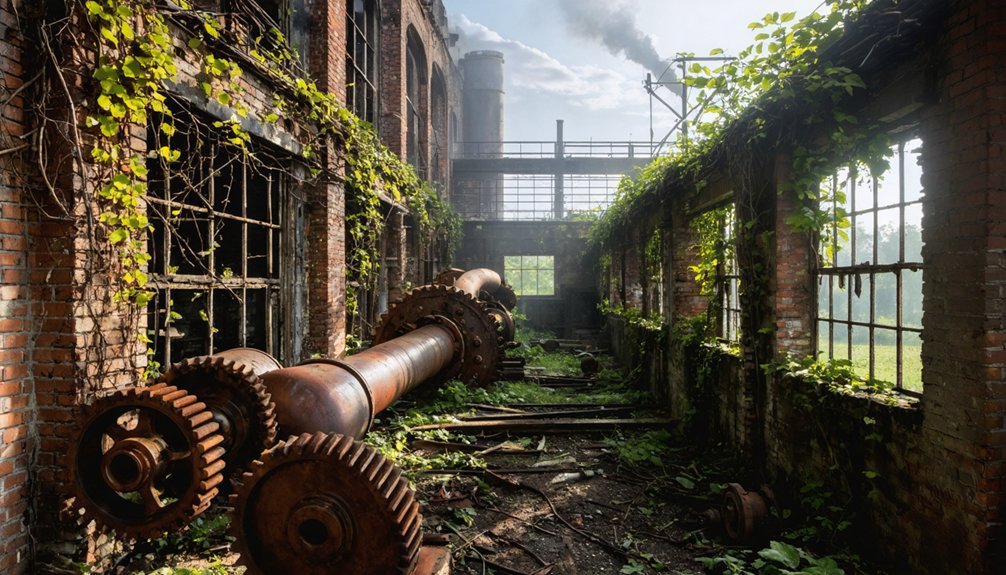
While you can still witness the historic architecture of Alma’s original 1789 plantation, today’s sugar mill operations reflect modern industrial prowess, processing sugarcane from roughly 60,000 acres annually.
As one of Louisiana’s last 11 operational sugar mills, Alma’s facility produces an impressive 500 million pounds of raw sugar and 10 million gallons of molasses each year.
You’ll find this unique blend of history and modern industry has helped sustain the local economy, providing essential employment during grinding season while preserving the site’s cultural significance.
Historic Production Methods Here
Since its establishment, Alma Plantation’s sugar mill has stood as a reflection of Louisiana’s evolving sugar production methods, processing roughly 60,000 acres of sugarcane annually into 500 million pounds of raw sugar.
The historic milling operation transformed from open-kettle boiling to steam power by 1861, marking a pivotal shift in sugar extraction technology.
You’ll find these revolutionary changes preserved at Alma:
- Mechanized equipment boosted processing from 130 to 600 tons per hour
- Advanced sugar recovery techniques yielded 230 pounds per ton of cane
- Imbibition technology doubled extraction rates through water washing
The mill’s self-sufficient energy system burns bagasse for steam power, while modern welded mill rolls maintain ideal roughness for juice extraction.
Traditional bells and steamboat whistles still mark the grinding season, connecting present operations to the past.
Modern Operations Continue Today
Although many historic Louisiana sugar mills have closed their doors, the Louisiana Sugarcane Cooperative mill near St. Martinville stands as a symbol of economic sustainability in the region.
You’ll find modern sugar technology at work here, with the mill processing an impressive 36 tons of cane per acre and yielding over 250 pounds of sugar per ton.
Despite industry-wide consolidation, this mill’s continued operation showcases the strength of Louisiana’s sugar production.
You can witness the evolution of farming practices, including the adoption of billet planting and the cultivation of hardy L 01-299 cane varieties.
The mill’s success isn’t just about numbers – it’s maintaining vital jobs and supporting local farmers while adapting to changing times.
Even with a 5% decrease in harvested acreage statewide, total sugar production increased by 2.9% in 2024.
Life Along the Mississippi Valley
Long before European explorers set foot in the Mississippi Valley, diverse Indigenous cultures thrived along its banks for thousands of years.
Native peoples built rich civilizations along the Mississippi for millennia, creating a tapestry of cultures before European arrival.
You’ll find evidence of sophisticated societies that evolved from hunter-gatherers into complex chiefdoms, using the mighty river for trade, travel, and sustenance.
When you explore the valley’s rich history, you’ll discover:
- Numerous tribes including the Sioux, Choctaw, and Natchez developed intricate social and economic networks
- Monumental earthworks and mounds showcase the architectural achievements of river commerce
- The Mississippi served as a crucial highway, connecting different Indigenous peoples and facilitating cultural exchange
This vibrant Indigenous life transformed after European contact, first with Spanish explorers in 1541, followed by French expeditions that forever changed the river’s destiny through colonization and territorial claims.
Remnants of a Bygone Era
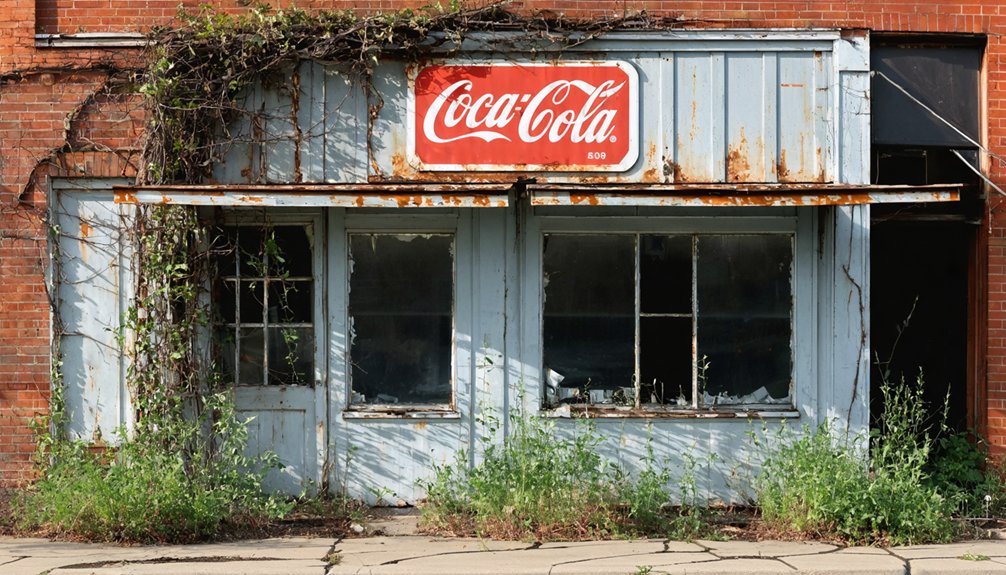
Today’s visitors to Alma, Louisiana will find scattered remnants of what was once a bustling sugar mill town in Pointe Coupee Parish.
You’ll discover foundations and building materials that occasionally surface, revealing the original community layout of this forgotten settlement. The most prominent remains include parts of the sugar mill operations, one of Louisiana’s few surviving historic mill sites.
When water levels drop at Lexington Reservoir, you can spot underwater remnants that offer glimpses into 19th-century life.
Archaeological findings have unearthed tools, building fragments, and domestic items that tell the story of daily life in Alma. While most residential and commercial structures have vanished, old roads and pathways linking to neighboring towns remain visible on satellite imagery, though they’re often obscured by vegetation.
Agricultural Heritage Today
Despite its ghost town status, Alma’s agricultural legacy thrives through the Stewart family’s modern operation of one of Louisiana’s largest sugarcane enterprises.
You’ll find that sugarcane sustainability remains at the heart of this 2,500-acre operation, processing an impressive 6,000 tons of cane daily while preserving community traditions that date back to 1789.
- The plantation’s original layout stands preserved, making it unique among Louisiana’s working plantations.
- Historic worker cottages from the 1920s continue to house laborers, bridging past and present.
- The Alma General Store serves as a community hub, maintaining local connections amid industrial growth.
The Stewart family’s fourth-generation leadership balances modern innovation with heritage, exemplified by their expansion into rum production through Cane Land Distilling Co.
They maintain traditional harvest-time practices like ceremonial bell-ringing.
Frequently Asked Questions
Are There Any Accessible Historic Buildings or Ruins to Visit in Alma?
You won’t find accessible historic buildings or ruins for ghost town exploration in this area. While industrial heritage continues through an active sugar mill, historic preservation hasn’t maintained visitable structures.
What Was the Peak Population of Alma Before Becoming a Ghost Town?
You won’t find exact peak population records in Alma’s history, though research suggests it likely never exceeded 1,000 residents, with numbers fluctuating seasonally due to sugar mill operations before becoming a ghost town.
Does Anyone Still Live Within Alma’s Original Town Boundaries Today?
No, you won’t find any current residents within Alma’s original town boundaries. Today’s land use is purely industrial, centered around the sugar mill operations that replaced the town’s historical residential areas.
What Happened to the Original Alma Plantation House and Structures?
You’ll find that Alma’s original 1789 plantation house no longer exists, though historical records don’t specify its exact fate. Modern structures, including 1920s worker cottages, have replaced the original plantation architecture.
Can Tourists Visit the Operating Sugar Mill in Alma?
You can’t tour the operating sugar mill as it’s closed to public visitors. While Alma’s General Store and distillery are local attractions, the industrial mill maintains restricted access for safety reasons.
References
- https://etsn.fm/ixp/33/p/7-louisiana-ghost-towns/
- https://en.wikipedia.org/wiki/List_of_ghost_towns_in_Louisiana
- https://k945.com/these-3-louisiana-ghost-towns-are-just-a-road-trip-away/
- https://www.sfgate.com/obscuresf/article/brief-history-of-a-Bay-Area-ghost-town-17397657.php
- https://710keel.com/discover-70-ghost-towns-from-across-louisiana/
- https://kids.kiddle.co/List_of_ghost_towns_in_Louisiana
- https://www.shreveporttimes.com/story/news/2025/09/04/does-louisiana-have-any-ghost-towns-how-many-are-there-where-to-find-abandoned-towns/85972403007/
- https://classicrock1051.com/16-ghost-towns-in-louisiana/
- https://en.wikipedia.org/wiki/Lakeland
- http://genealogytrails.com/lou/pointecoupee/plantations.html
